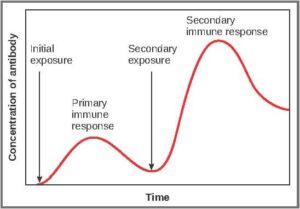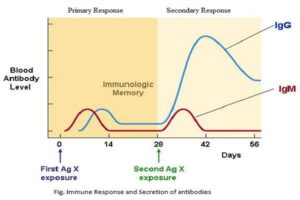Back to: MICROBIOLOGY 100 LEVEL
Welcome to class!
It’s great to have you here again! Today’s topic is something your body experiences almost every time it fights off an infection or receives a vaccine—Primary and Secondary Immune Responses. These responses are how your body remembers a germ and reacts more strongly the next time it shows up. It’s just like learning—when you study something for the first time, you may be slow. But when you see it again, you’re quicker and better at it!
Let’s break this down in a simple and relatable way.
Primary And Secondary Immune Responses
Your immune system has a kind of memory. When it encounters a germ (called an antigen) for the first time, it takes a bit of time to figure out how to respond. This is called the primary immune response. But the next time it meets the same germ, it remembers it and responds much faster and stronger. That’s the secondary immune response.
Primary Immune Response
This is the immune system’s first reaction to a new antigen.

It usually takes 5 to 14 days to produce enough antibodies to fight off the infection.
During this time, you might feel sick because the body is still learning how to handle the invader.
In this stage, IgM antibodies are produced first. Later on, IgG antibodies are made.
Example: When a child is infected with measles for the first time, their immune system takes time to respond. That’s why they may be sick for a few days while the body figures out how to fight it.
Secondary Immune Response
This occurs when the body is exposed to the same antigen again.
It’s faster, stronger, and longer-lasting than the primary response.
This time, the immune system remembers the antigen, thanks to memory B and T cells.
IgG antibodies are produced quickly in large amounts, often preventing any symptoms.
Example: If that same child is exposed to measles again years later, they won’t get sick. Their immune system remembers the virus and responds immediately.

This is also how vaccines work. A vaccine introduces a harmless part of a germ so your body can develop a primary response. If the real germ appears later, your body gives a strong secondary response and stops it before it causes illness.
Summary
- The primary immune response is the body’s first response to a new antigen, usually slow and mild.
- The secondary immune response is faster, stronger, and longer because of memory cells.
- IgM antibodies are produced first in the primary response; IgG dominates in the secondary response.
- The secondary response protects you from getting sick again by quickly removing the germ.
- This is how vaccines provide long-term protection.
Evaluation
- What is the main difference between a primary and secondary immune response?
- Which type of antibody is produced first during a primary immune response?
- Why is the secondary response faster than the primary response?
- How do vaccines use this immune memory to protect us?
You’ve just learned how your body gets smarter each time it faces a germ. That’s powerful knowledge! Keep believing in yourself, and remember that every lesson is a step closer to your dreams. Afrilearn is right here with you—see you in the next class!
